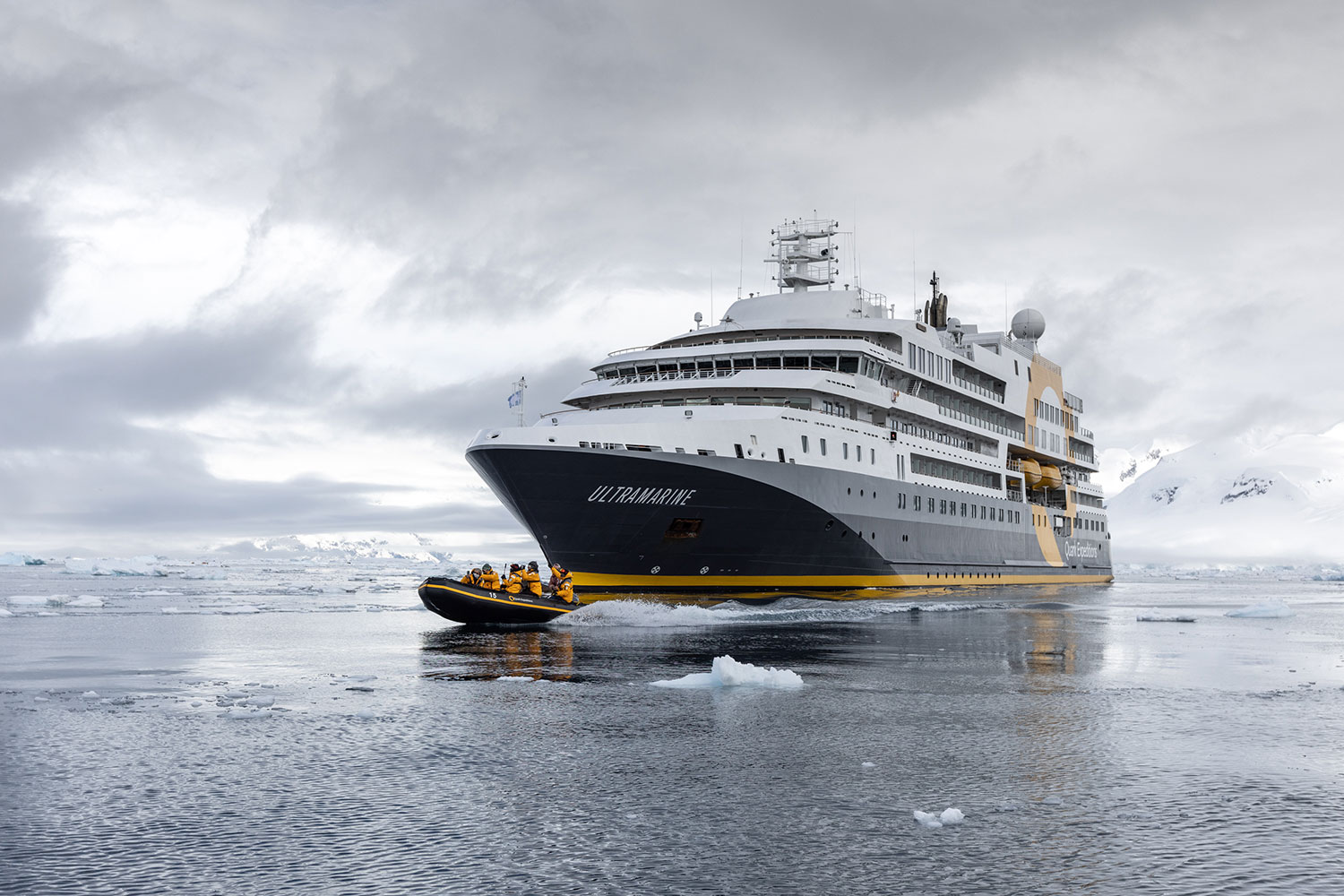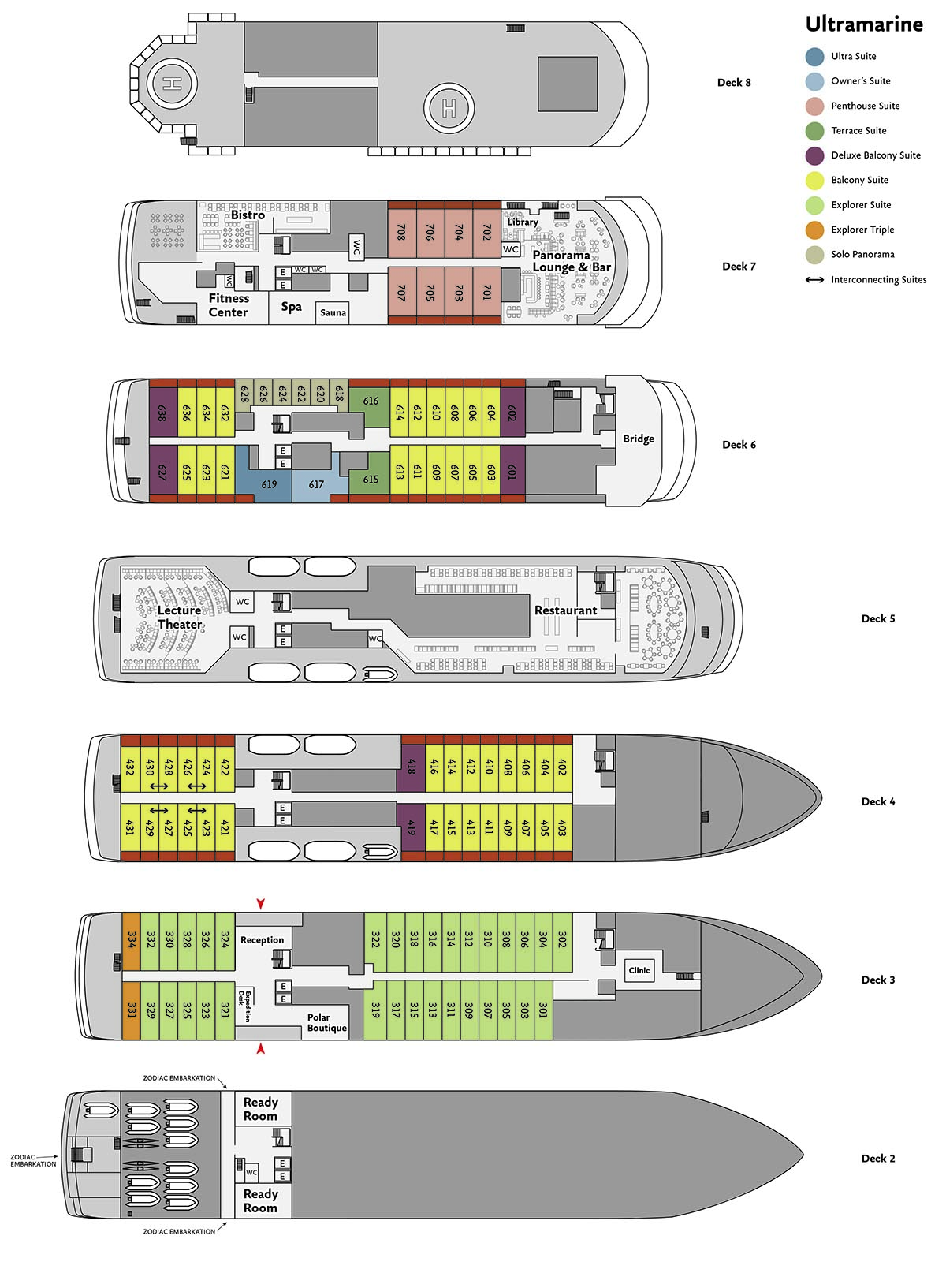Arctic Saga: Spitsbergen, Faroes & Jan Mayen: Ultramarine
North Atlantic
The Arctic Saga: Exploring Spitsbergen via the Faroes and Jan Mayen itinerary will have you traveling under the midnight sun to some of the most remote islands on the planet, where only a small number of adventurers have ever left their footprints. Sailing across the North Atlantic, you’ll be immersed in the region’s rugged beauty and whaling and Viking history, visiting the awe-inspiring and unspoiled destinations of Fair Isle, the Faroe Islands, Jan Mayen and Spitsbergen
- Encounter iconic Arctic wildlife, such as whales, reindeer, seals, seabirds and the iconic polar bear
- Explore the volcanic and glacier-covered Jan Mayen island, in the heart of the North Atlantic Ocean
- Visit abandoned whaling stations, a bird observatory and other signi cant sites, and learn about the storied history of the region
- Cruise in a Zodiac to get up close to wildlife and diverse landscapes
On Sale
Discounted sale prices as shown
Stewart's Take
From Scotland to Svalbard - head out into the wild!
Overview
The Arctic Saga: Exploring Spitsbergen via the Faroes and Jan Mayen itinerary will have you traveling under the midnight sun to some of the most remote islands on the planet, where only a small number of adventurers have ever left their footprints. Sailing across the North Atlantic, you’ll be immersed in the region’s rugged beauty and whaling and Viking history, visiting the awe-inspiring and unspoiled destinations of Fair Isle, the Faroe Islands, Jan Mayen and Spitsbergen. Towering fjords, massive glaciers, soaring sea stacks and coastal cliffs teeming with thousands of seabirds, like the amazing Atlantic puffin, will take your breath away. So too will the diverse wildlife of this far-flung region, from Svalbard reindeer to dolphins, seals and whales. Having continuous daylight for part of the voyage means optimum chances to spot these magnificent creatures in their natural habitat at any time of day… or night!Luxury Expedition Vessel: Ultramarine

The newest ship in Quark's fleet, Ultramarine, is designed to go beyond the familiar in polar exploration, to discover new places, and to immerse you in the best the region has to offer. Equipped with two twin-engine helicopters for extraordinary sightseeing, this outstanding vessel offers the widest range of adventure activities in the industry, the most spacious suites in its category, breathtaking public spaces, and more outdoor wildlife viewing spaces than other expedition ships its size. It also features an innovative mix of sustainability features that exceed all industry standards. With all this and more, Ultramarine is set to give you the ultimate polar expedition experience!

- Shipboard accommodation with daily housekeeping
- All breakfasts, lunches, dinners, and snacks on board throughout your voyage
- All shore landings per the daily program
- Leadership throughout the voyage by our experienced Expedition Leader
- A daily program of lectures by noted naturalists
- All Zodiac transfers and cruising per the daily program
- Formal and informal presentations by our Expedition Team and Special
- Guests as scheduled
- Photographic Journal on DVD, documenting the voyage
- A pair of waterproof expedition boots on loan for shore landings
- An official Quark Expeditions® parka to keep
- Coffee, tea and cocoa available around the clock
- A selection of alcoholic and non-alcoholic beverages
- Hair dryer and bathrobe in every cabin
- Comprehensive pre-departure materials, including a map and an informative
- Arctic Reader
- All miscellaneous service taxes and port charges throughout the program
- All luggage handling aboard ship
- Arrival transfer from Longyearbyen airport to your hotel if you arrive one day prior to embarkation
- On embarkation day transfer from your hotel or Longyearbyen airport to the ship
- On disembarkation day group transfer from the ship to airport or local designated drop-off location
- Emergency Evacuation Insurance for all passengers to a maximum benefit of US$100,000 per person
- International airfare
- Passport and any applicable visa expenses
- Government arrival and departure taxes not mentioned above
- Any meals ashore with the exception of breakfast at the host hotel
- Baggage, cancellation, interruption, and medical travel insurance
- Excess baggage charges
- Laundry and other personal charges
- Telecommunications charges
- The voluntary gratuity at the end of the voyage for shipboard staff and crew
- Any overnight accommodation required due to flight connections
- Optional sea-kayaking activities
- Cancellations received 120 days or more prior to departure, are refundable less an administrative fee of US$500/€450/AUD650/GBP400/SEK5500 per person.
- If cancellation is received between 119 days and 90 days, the deposit is forfeited.
- If cancellation occurs between 89 days and 60 days prior to departure, the cancellation fee is 75% of the expedition cost.
- If cancellation occurs between 59 days and departure, the cancellation fee is 100% of the expedition cost.

Tour Dossier
Arctic Saga: Spitsbergen, Faroes & Jan Mayen: Ultramarine

This 14 day expedition aboard the luxurious Ultramarine visits remote North Atlantic islands up to the Arctic wilderness of Svalbard
File Creation date: 2024-07-27 - for updated information and dates and prices see the following page:
http://expeditionsonline.com/tour/arctic-saga-spitsbergen-faroes-jan-mayen-ultramarine_427

Arctic Saga: Spitsbergen, Faroes & Jan Mayen: Ultramarine
Duration: 14 days
Location: North Atlantic
Available: April-May
Start: Aberdeen, Scotland
Finish: Longyearbyen, Norway (with flight to Helsinki)

Highlights
- Encounter iconic Arctic wildlife, such as whales, reindeer, seals, seabirds and the iconic polar bear
- Explore the volcanic and glacier-covered Jan Mayen island, in the heart of the North Atlantic Ocean
- Visit abandoned whaling stations, a bird observatory and other signi cant sites, and learn about the storied history of the region
- Cruise in a Zodiac to get up close to wildlife and diverse landscapes

Itinerary
The Arctic Saga: Exploring Spitsbergen via the Faroes and Jan Mayen itinerary will have you traveling under the midnight sun to some of the most remote islands on the planet, where only a small number of adventurers have ever left their footprints. Sailing across the North Atlantic, you’ll be immersed in the region’s rugged beauty and whaling and Viking history, visiting the awe-inspiring and unspoiled destinations of Fair Isle, the Faroe Islands, Jan Mayen and Spitsbergen




Ship Information
Luxury Expedition Vessel: Ultramarine

The newest ship in Quark's fleet, Ultramarine, is designed to go beyond the familiar in polar exploration, to discover new places, and to immerse you in the best the region has to offer. Equipped with two twin-engine helicopters for extraordinary sightseeing, this outstanding vessel offers the widest range of adventure activities in the industry, the most spacious suites in its category, breathtaking public spaces, and more outdoor wildlife viewing spaces than other expedition ships its size. It also features an innovative mix of sustainability features that exceed all industry standards. With all this and more, Ultramarine is set to give you the ultimate polar expedition experience!

Arctic Saga: Spitsbergen, Faroes & Jan Mayen: Ultramarine
For the latest, up-to-date departure dates and prices please refer to the tour page:
http://expeditionsonline.com/tour/arctic-saga-spitsbergen-faroes-jan-mayen-ultramarine_427
- Cancellations received 120 days or more prior to departure, are refundable less an administrative fee of US$500/€450/AUD650/GBP400/SEK5500 per person.
- If cancellation is received between 119 days and 90 days, the deposit is forfeited.
- If cancellation occurs between 89 days and 60 days prior to departure, the cancellation fee is 75% of the expedition cost.
- If cancellation occurs between 59 days and departure, the cancellation fee is 100% of the expedition cost.
Included
- Shipboard accommodation with daily housekeeping
- All breakfasts, lunches, dinners, and snacks on board throughout your voyage
- All shore landings per the daily program
- Leadership throughout the voyage by our experienced Expedition Leader
- A daily program of lectures by noted naturalists
- All Zodiac transfers and cruising per the daily program
- Formal and informal presentations by our Expedition Team and Special
- Guests as scheduled
- Photographic Journal on DVD, documenting the voyage
- A pair of waterproof expedition boots on loan for shore landings
- An official Quark Expeditions® parka to keep
- Coffee, tea and cocoa available around the clock
- A selection of alcoholic and non-alcoholic beverages
- Hair dryer and bathrobe in every cabin
- Comprehensive pre-departure materials, including a map and an informative
- Arctic Reader
- All miscellaneous service taxes and port charges throughout the program
- All luggage handling aboard ship
- Arrival transfer from Longyearbyen airport to your hotel if you arrive one day prior to embarkation
- On embarkation day transfer from your hotel or Longyearbyen airport to the ship
- On disembarkation day group transfer from the ship to airport or local designated drop-off location
- Emergency Evacuation Insurance for all passengers to a maximum benefit of US$100,000 per person
Excluded
- International airfare
- Passport and any applicable visa expenses
- Government arrival and departure taxes not mentioned above
- Any meals ashore with the exception of breakfast at the host hotel
- Baggage, cancellation, interruption, and medical travel insurance
- Excess baggage charges
- Laundry and other personal charges
- Telecommunications charges
- The voluntary gratuity at the end of the voyage for shipboard staff and crew
- Any overnight accommodation required due to flight connections
- Optional sea-kayaking activities
General Terms and Conditions
Expeditions Online Newsletter
Sign up to be an Expeditions Online insider and receive info on exclusive deals, discounts and more!